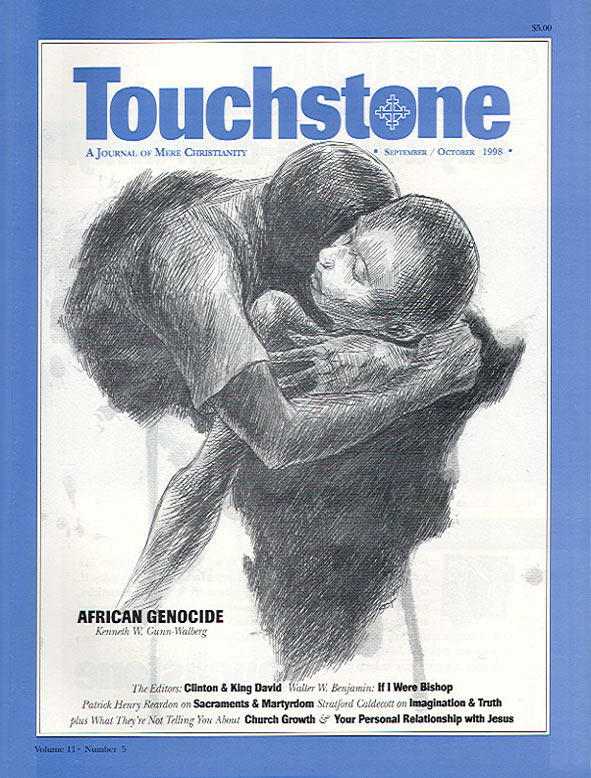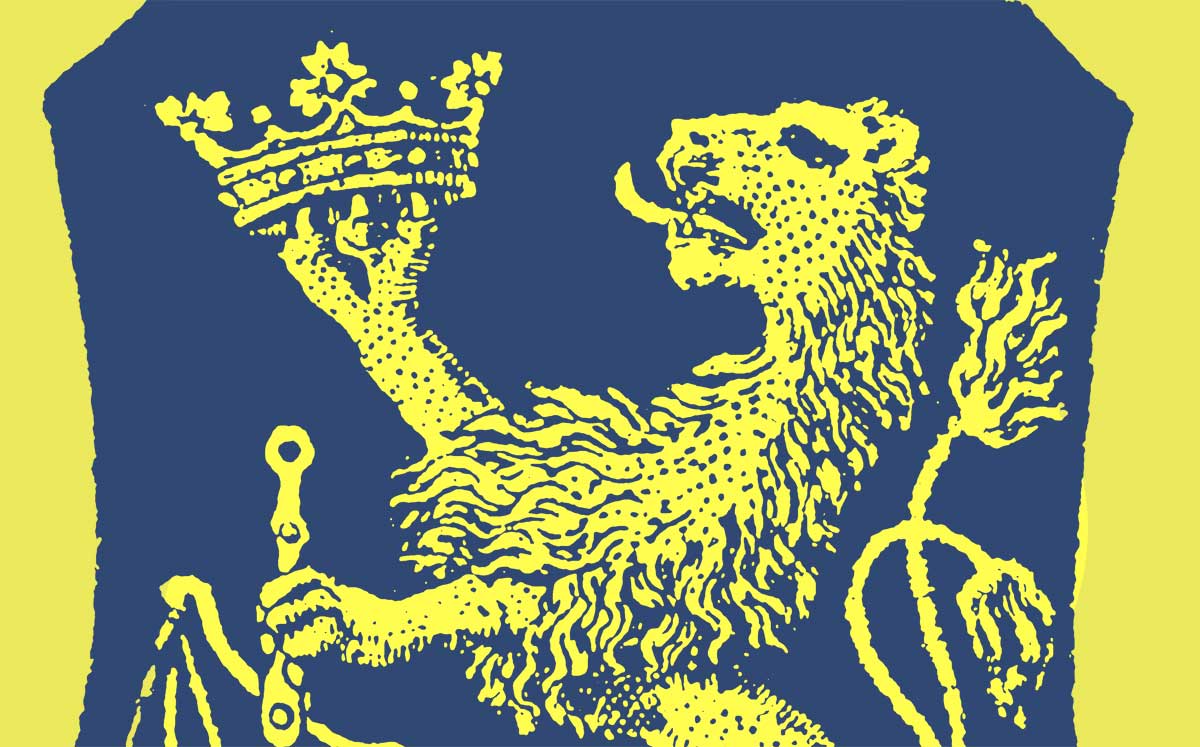Feature
Speaking the Truths Only the Imagination May Grasp
An Essay on Myth &“Real Life”
John Henry Newman once pointed out that it is very hard for anyone to believe something he cannot first imagine to be true. Today, many people growing up in an industrialized world cut off (physically and intellectually) from the natural environment cannot imagine the milk they drink coming from a cow, let alone how the supernatural claims of Christianity could possibly be true. It seems to bear no relation to the world they inhabit. They have no knowledge of it, nor even any knowledge from which they can draw analogies.
Their imagination (by which I mean that faculty by which they view the world and try to make sense of it) is shaped by technological rather than organic forms. They consequently have difficulty believing that everything in the world grows in order to manifest an inner, invisible unity and to believe that something, some being, created and maintains that unity. For children growing up in a modern city, the world is composed of physical objects jammed together by an external logic or more often by no apparent logic at all: noisy and random, forming no natural order but jostling and fighting for dominance, a unity based on power.
Life was not always so. A life lived close to the earth, to nature in all its forms—plants and animals, rocks and rivers—helps to create in a child the possibility of religious awakening. For those children estranged from nature, the early influence of good literature can have the same salutary effect. Traditional folk and fairy tales, heroic stories, and legends can help in preparing someone for what C. S. Lewis referred to as the “baptism” of the imagination; something that for him, albeit not for everyone, was an important preparatory step for receiving the gospel of Christ as Saving Truth.
In my own case, these things helped to wake a longing that could not be satisfied by the kind of knowledge offered by science alone. It was a longing that, once awakened, could not easily be lulled to sleep.
A Longing for Union
This longing has been experienced by men and women of all cultures and times. It is not merely the longing for an explanation of why the world exists at all, although that may come into it. It is a longing for union with something infinitely remote and yet infinitely beautiful; a longing for self-transformation, for the One who entirely transcends our present state. This is the longing that myths evoke, and the fulfillment of which they speak. As Lewis said in his sermon “The Weight of Glory,” God has given us such great wonders in nature that we should not want anything else, but
we want so much more—something the books on aesthetics take little notice of. But the poets and mythologies know all about it. We do not want merely to see beauty, though, God knows, even that is bounty enough. We want something else which can hardly be put into words—to be united with the beauty we see, to pass into it, to receive it into ourselves, to bathe in it, to become part of it. That is why we have peopled air and earth and water with gods and goddesses and nymphs and elves.1
Yet it would be a mistake to dismiss our myths merely as “wishful thinking” and nothing more. As J. R. R. Tolkien wrote, “legends and myths are largely made of ‘truth,’ and indeed present aspects of it that can only be received in this mode.”2 In the popular meaning of the word, of course, a myth is simply a story that is not true. I would say rather that a myth is a symbolic story intended to express truth, and a truth perhaps best apprehended and understood through story. Myth, wrote Lewis, “must be grasped with the imagination, not with the intellect.” If its characters
have some touch of mythical life, then no amount of “explanation” will quite catch up with their meaning. It is the sort of thing you cannot learn from definition: you must rather get to know it as you get to know a smell or taste, the “atmosphere” of a family or a country town, or the personality of an individual.3
But what is myth designed to express? It concerns not merely the world around us, but the world within us; not so much the surface appearance of the world, but its inner form. For a myth is a way of describing the rules by which the world is made, the rules that govern our lives; whether or not we know them or obey them. In a phrase from The Lion, the Witch and the Wardrobe, they reveal “the deep magic from before the dawn of time.”
I suppose, even so, that we should properly restrict the name of myth to those stories that encapsulate the religious and cosmological beliefs of an entire community. But the line between myth, folklore, “fairy tales,” and fantasy is hard to draw. Stories composed by an individual, such as Hans Christian Andersen’s Snow Queen, Tolkien’s The Lord of the Rings, or Lewis’s Chronicles of Narnia, seem sometimes to touch the same level of archetypal truth as the myths of a people, and they achieve enormous and lasting popularity as a result. In the case of the leading “Inklings,” this amounted to a cult following within their own lifetime.
Fantasy “fandom” may be obsessive, but fundamentally it springs from a healthy response to a sick—a fallen—world. Given the situation in which we find ourselves, even escapism is not necessarily ignoble. To quote Tolkien’s essay “On Fairy Stories”:
In what the misusers [of the term “escape”] are fond of calling Real Life, Escape is evidently as a rule very practical, and may even be heroic. . . . Why should a man be scorned, if, finding himself in prison, he tries to get out and go home? . . . Or if, when he cannot do so, he thinks and talks about other topics than jailers and prison-walls? The world outside has not become less real because the prisoner cannot see it.4
Lewis put it a similar way: “At present we are on the outside of the world, the wrong side of the door. We discern the freshness and purity of morning, but they do not make us fresh and pure. We cannot mingle with the splendours we see.”5
What follows is partly an examination of this attempt to “go home,” to return to the world outside the prison walls. It is about how we can better understand our own lives in the light of mythic imagination and the relationship of Christianity to mythology. The stories I have chosen to reflect briefly upon are stories of a Quest. The quest is, after all, probably the best-known “plot device” of all folklore and mythology. If the first task of the storyteller is to hold the interest of his listeners, clearly what people find most interesting is a tale that describes a journey in which there is some difficult goal to be achieved, some challenge to be met, some initiation to be undergone, some place or object to be discovered or won.
Why are such tales so endlessly fascinating, so universally told? Perhaps because it is just such a journey that gives meaning to our own existence. We read or listen to the storyteller in order to orient ourselves within—to learn how to behave in order to get where we are going. Each of us knows that our life is not merely a mechanical progress from cradle to grave; it is a search, a quest, even a pilgrimage. There is some elusive goal that motivates us in our work and our play.
Christianity as Myth
The definition of “myth” as a symbolic story designed to express truth is broad enough to apply to the stories we find in the Bible. Of course, there is nothing in our definition that rules out the possibility that at least some of these stories may also be true accounts of historical events. The traditional understanding is that they are both. Wherever the text of the Bible does not appear to contradict itself, or is not contradicted by human reason or by certain knowledge from some other sources, tradition encourages us to assume that it is literally as well as symbolically true—that is, true to the surface as well as to the inner life of the world.
Both the Jewish philosopher Philo of Alexandria and the third-century theologian Origen expressly stated this as a principle of interpretation. We could call it the principle of “Maximum Possible Meaning.” Behind it lies the conviction that the divine author of Scripture is also the author of the cosmos, and so the Book of Nature must be reflected in the Book of Scripture, and find there its definitive interpretation.
At one time Lewis regarded the Bible, and the whole Christian story, as no more than a fairy tale dressed up as truth, a “lie breathed through silver.” It is easy to see why. Fairy stories as well as many of the classical myths and legends contain many themes, stories, and ideas we also find in the Christian story.
In particular, a hero is generally marked out from birth for a special destiny. He has been born into a time and place in need of some sort of deliverance, usually from an oppressive ruler (who may or may not have supernatural powers). His birth is often marked by some supernatural mark of favor; indeed, he may even be the son of a god. On reaching maturity, he receives his task: a task only he can fulfill. He may have a time of trial before he begins, in which he has to resist temptations that will divert him from his task. The task may involve the recovery of a lost treasure guarded by a dragon, or the undoing of the enchantment that lies over a kingdom, or winning the hand of a princess; often it involves all three.
Jesus Christ fits this pattern for the hero. Just as he fulfills the prophecies of the Old Testament, he also fulfills the universal archetype of the mythic hero (although in both cases he does so partly by turning expectations on their head). He is born to a virgin and is called the “son of God.” He enters a world oppressed and enslaved (primarily by sin, but also by the Romans). He receives his mission when he is baptized in the Jordan; the Holy Spirit then drives him into the desert for a time of trial; there he battles spiritually with the “dragon” Satan; he returns from this skirmish to recover the lost treasure of his Father’s kingdom, the human race; by giving his life for his friends he succeeds in undoing the enchantment of Original Sin; finally he is raised to new life and, in the book of Revelation, is rewarded with the hand of the “princess” Israel, the “new Jerusalem . . . prepared as a bride” (21:2). The story of Jesus Christ is, clearly, whatever else it may be, a myth.
Lewis’s view that Christianity was merely a fairy tale met with an unexpected response when he discussed it with Tolkien, during a long walk one day around Magdalen College in Oxford.6 Yes, Tolkien said, the Gospels contain a fairy story—even the sum total of all fairy stories rolled together—the one story we would most wish to be true in all literature. But although we cannot make the story true by wishing, and we must not deceive ourselves into thinking it is true because we wish it, we still cannot rule out the possibility that it did all actually happen.
It may be that the very reason we wish it were true is that we were made to wish it, by the One who makes it true. God created us incomplete, because the kind of creature that can only be perfected by its own choices (and so through Quest and trial) is more glorious than the kind that has only to be whatever another made it to be.
Lewis was haunted by a comment on the Gospels by a “hard-boiled atheist,” a man he very much admired for the toughness and objectivity of his mind: “Rum thing, all that stuff of Frazer’s about the Dying God. Rum thing. It almost looks as if it had really happened once.”7 Much later, in a letter to his childhood friend Arthur Greaves, Lewis wrote how he had gradually and with reluctance come to believe that
the story of Christ is simply a true myth; a myth working on us in the same way as the others, but with this tremendous difference, that it really happened; and one must be content to accept it in the same way, remembering that it is God’s myth where the others are men’s myths: i.e. the Pagan stories are God expressing himself through the minds of poets, using such images as he found there, while Christianity is God expressing himself through what we call “real things.” Therefore it is true, not in the sense of being a “description” of God (that no finite mind could take in) but in the sense of being the way in which God chooses to (or can) appear to our faculties. The “doctrines” we get out of the true myth are of course less true; they are translations into our concepts and ideas of that which God has already expressed in a language more adequate, namely the actual incarnation, crucifixion and resurrection.8
For Christians it is obvious that the life of Christ will fulfill all myths and fairy tales because it is the Way, the Truth, and the Life within all lives. It is the Drama within all drama, the Story that all good stories reflect. The overcoming of death by infinite Love is the Quest at the heart of every quest, and the sacrifice that makes it possible is the essence of all heroism. In the Gospels, literal truth and universal symbolism, history and legend, time and eternity coincide. They are brought together by the “hypostatic union” of divine and human nature.
And this upsets what Lewis called “the whole demythology of our time,” the assumption that the biblical stories—the Christian myth—are only symbolic and can be revised or abandoned as needed, if they prove themselves “inadequate to our thoughts.”
But supposing these things were the expressions of God’s thought? . . . You cannot know that everything in the representation of a thing is symbolical unless you have independent access to the thing and can compare it with the representation. . . . How if we are asking about a transcendent, objective reality to which the story is our sole access? “We know not—of we know not.” But then we must take our ignorance seriously.9
If the myth comes from God, it is likely to mix symbolic and literal truth in ways we, fallen creatures, cannot see. “When I know as I am known I shall be able to tell which parts of the story were purely symbolical and which, if any, were not; shall see how the transcendent reality either excludes or repels locality, or how unimaginably it assimilates and loads it with significance. Had we not better wait?”
All this sets the scene for what the Swiss theologian Hans Urs von Balthasar describes as the “theo-drama”: a drama enacted by God the Son, written by God the Father, and directed by the Holy Spirit. Each of us is offered a role in this cosmic drama, a mission to perform in mythic space. In relation to Christ, “each individual is given a personal commission; he is entrusted both with something unique to do and with the freedom to do it. Bound up with commission is his own, inalienable, personal name; here and only here role and person coincide.”10
The English word “person” derives from the Etruscan phersu and the Latin persona, meaning an actor’s role or mask. Thus the word originally referred to the face that the actor assumed for the purpose of participating in a drama. For an actor, of course, real life is what happens when he takes the mask off. Christianity reverses the relationship. Real life is what happens when he puts it on. The play, the cosmic theo-drama, is more real than what happens out of character and “off-stage.” It is only by accepting and carrying out a drama, that is, in the myth, that we can become persons who are real for eternity.
Perhaps this sounds strange: that, like the Velveteen Rabbit, we still need to learn to become real. But it is what I have come to see as the distinctive message of Christianity. While agreeing with the oriental religions that we must dissolve the illusion of the “false self,” Christianity teaches, not the abolition of the self, but that we may inherit a new self that is not illusory. This new self, the persona, is distinct from God by nature, but united with him through grace.
Fundamentalism and Myth
In his remark about “doctrines,” we see why Lewis, even after he came to believe in the literal, historical truth of the Christian myth, could not be dismissed as a fundamentalist. A fundamentalist is one who reduces religion to the size of his own mind. He mistakes the pointing finger for the moon, relative truth for absolute, the human definition for the reality.
But, as mentioned, believing something to be a historical fact need not prevent us from seeing it as a symbolical truth as well. It is because water is an apt natural symbol of birth and of death that God uses it to bring about rebirth in the sacrament of baptism. Lewis was not a fundamentalist; he was a sacramentalist. His religion was mystical. A fundamentalist will build a fence around a teaching to “protect” it; but he will never, like Lewis, permit that dogma to sink its roots deep into the earth, nor grow above his fence into the sky. Yet that is what it must do in those people whose faith is a living, growing thing—like the tree of the parable that starts as the smallest of seeds, but grows until the birds of the air can nest in its branches.
Lewis’s stories of the land of Narnia (written, of course, twenty years and more after his conversion) revolve around a Quest, reflecting in a hundred ways the understanding he had attained of the human heart and its ways to God—the drama of human and divine freedom. Narnia was the name of Lewis’s own “inner kingdom,” and the diversity of its talking animal inhabitants subject to a human king expresses the primordial harmony with nature that exists in every rightly ordered soul.
Each story in the series deals with a particular threat to this world within the heart, or test of allegiance to it. The recurrent subtheme of the “royal child” is not merely a device for holding the attention of Lewis’s young readers, but has its roots in the Gospel saying: “Unless you become like this child, you will not enter the Kingdom of Heaven.” Lewis had perceived that it is only by restoring childlike innocence to the heart that our lives can become capable of fulfillment. “Blessed are the pure in heart, for they shall see God.”
In the Chronicles of Narnia the reigns of the usurper Miraz, of the Witches, of the Calormenes, are each in a different way images of what we fallen grown-ups have slipped into calling “real life”: the world of adulthood, of cynicism, hypocrisy, “realism,” and despair. The “Earthmen” under the spell of the Green Witch work like ants, as though in a great joyless factory. The Telmarines drive the Talking Beasts and magic out of Narnia, building stone bridges to avoid getting their feet wet and regimented schoolrooms for teachers with names like Miss Prizzle. The Calormene rulers speak with great courtesy, but their words cover treachery and deceit and the basest political calculations.
Part of the great power of the books lies in the contrast they paint between “natural” and “artificial” worlds, a contrast that Lewis explained in a more philosophical mode in The Abolition of Man. When the White Witch’s ice begins to thaw, when the vines tear down the Bridge of Beruna, what we are meant to feel—what we surely do feel—is that here, at last, is real life again; and the “reality” we had previously accepted as inevitable in our own lives is somehow shown up to be nothing but an evil enchantment.
One example will suffice. At a crucial point in The Silver Chair, Eustace and Jill, the Prince they have rescued, and their companion the Marshwiggle Puddleglum are trapped by a Witch in her underground kingdom. They almost succumb to her spell, woven of music and smoke. They are almost persuaded that Narnia, Aslan, and even the sunshine of Overland are all childish illusions (myths or fairy tales, we would say). “You have seen lamps,” the Witch tells them, “and so you imagined a bigger and better lamp and called it the sun. You’ve seen cats, and now you want a bigger and better cat, and it’s to be called a lion. Well, ’tis a pretty make-believe, though, to say truth, it would suit you all better if you were younger.”11
With his last strength of will, Puddleglum steps into the fire, and the smell of his burning flesh weakens the spell. Then he replies to the witch:
One word, Ma’am. One word. . . . Suppose we have only dreamed, or made up, all those things, trees and grass and sun and moon and stars and Aslan himself. Suppose we have. Then all I can say is that, in that case, the made-up things seem a good deal more important than the real ones. Suppose this black pit of a kingdom of yours is the only world. Well, it strikes me as a pretty poor one.
This, he says, is “a funny thing.”
. . . We’re just babies making up a game, if you’re right. But four babies playing a game can make a play-world which licks your real world hollow. That’s why I’m going to stand by the play world. I’m on Aslan’s side even if there isn’t any Aslan to lead it. I’m going to live as like a Narnian as I can even if there isn’t any Narnia. So, thanking you kindly for our supper, if these two gentlemen and the young lady are ready, we’re leaving your court at once and setting out in the dark to spend our lives looking for Overland. Not that our lives will be very long, I should think; but that’s a small loss if the world’s as dull a place as you say.
Puddleglum’s argument is directed against the “spell” we all fall under the moment we enter (for example) the London Underground, the moment we sit down at a desk to earn money, the moment we forget to pray. It is one of the most powerful arguments for religious faith in the modern world that I have come across. We have faith not because we can immediately prove what we believe, but because it is in some way nobler to believe than to disbelieve.
We are “outside of the world,” on “the wrong side of the door.” Through myth, we see inside the world, get through the door. And we set about, through a deliberate decision, to act as though the myths were true, as if the greatest and most wonderful possible things were real things that, although they cannot be disproved (for the Witch’s clever arguments are no disproof), may take enormous courage to believe. It takes courage to believe, in today’s skeptical atmosphere, not that Jesus of Nazareth was a historical figure (for there is respectable evidence of that), but that he died and rose from the dead (for which we have a great deal of impressive testimony but no strictly “scientific” proof, and none that can easily overcome the intrinsic implausibility of the claim), and certainly that there is no other name in heaven or on earth by which we can be saved (for there is no “proof” of that at all).
We are back with the principle of Maximum Possible Meaning, this time applied to life itself. Religious faith is a categorical refusal to act as though the world were less important, less interesting, less meaningful, than we are capable of conceiving. It may be more; it will not be less. This may be a gamble, but if so it is a gamble that will give our lives meaning even if we are wrong. It will create an island of meaning in a sea of unmeaning.
“I’m going to live as like a Narnian as I can even if there isn’t any Narnia.” I am going to live as though Christ rose from the dead and calls me to follow. In this way, as Lewis found in his own life, Christian myth becomes Christian experience, and in due course, in God’s good time, the proofs from experience that we lacked in the beginning are ours as well. For we do not walk in the dark forever. •
“Speaking the Truths Only the Imagination May Grasp” is taken from The Pilgrim’s Guide: C. S. Lewis and the Art of Witness, edited by Touchstone senior editor David Mills and published by Eerdmans.
subscription options
Order
Print/Online Subscription

Get six issues (one year) of Touchstone PLUS full online access including pdf downloads for only $39.95. That's only $3.34 per month!
Order
Online Only
Subscription

Get a one-year full-access subscription to the Touchstone online archives for only $19.95. That's only $1.66 per month!
bulk subscriptions
Order Touchstone subscriptions in bulk and save $10 per sub! Each subscription includes 6 issues of Touchstone plus full online access to touchstonemag.com—including archives, videos, and pdf downloads of recent issues for only $29.95 each! Great for churches or study groups.
Transactions will be processed on a secure server.
more on imagination from the online archives

11.5—September/October 1998
Speaking the Truths Only the Imagination May Grasp
An Essay on Myth & 'Real Life' by Stratford Caldecott
more from the online archives
calling all readers
Please Donate
"There are magazines worth reading but few worth saving . . . Touchstone is just such a magazine."
—Alice von Hildebrand
"Here we do not concede one square millimeter of territory to falsehood, folly, contemporary sentimentality, or fashion. We speak the truth, and let God be our judge. . . . Touchstone is the one committedly Christian conservative journal."
—Anthony Esolen, Touchstone senior editor











